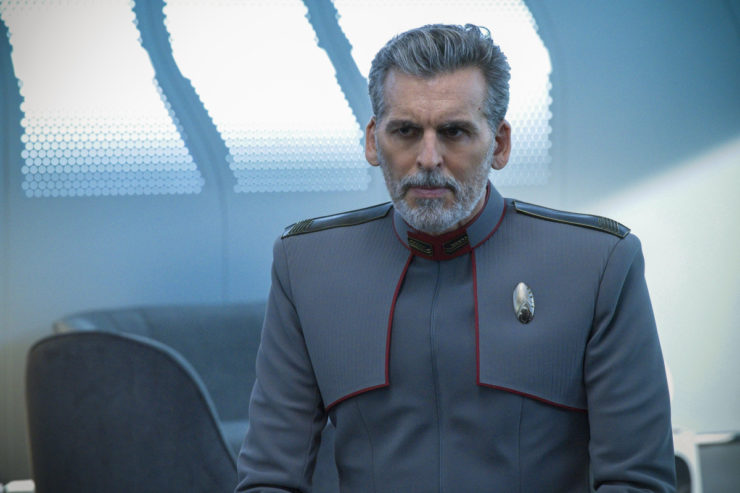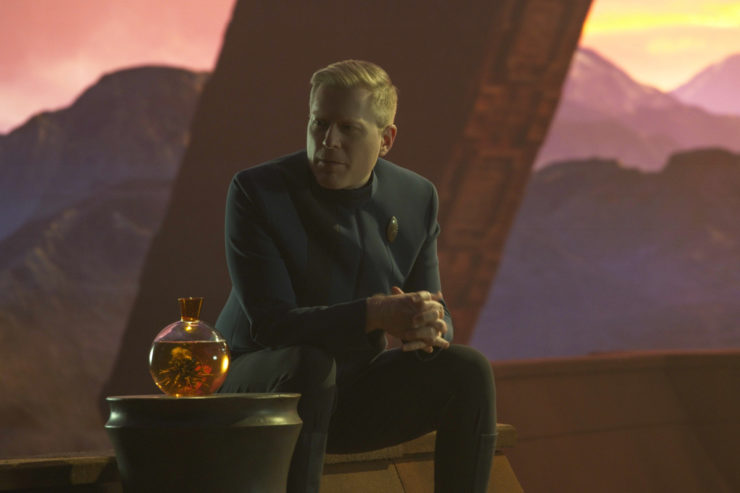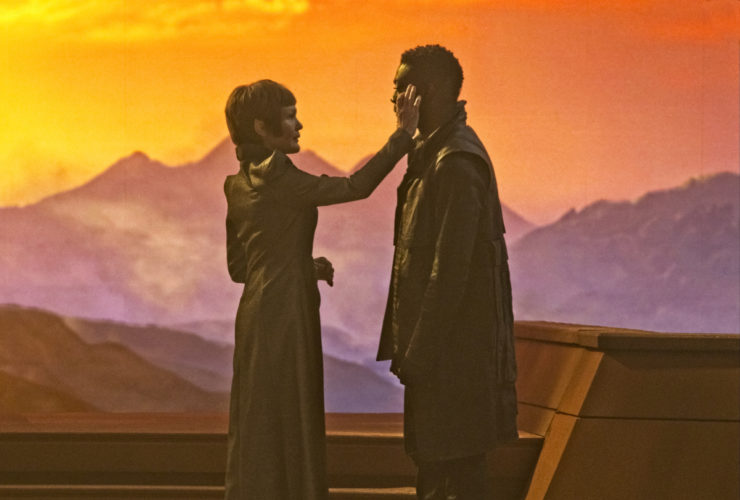There’s a lot to like about “Choose to Live,” but my personal favorite moment is toward the very end, when Vance and Burnham discuss the final disposition of the episode’s antagonist. Oded Fehr is simply brilliant here, aided by a superb script by Terri Hughes Burton, providing a canny and clever analogy that reminds Burnham—and the viewers—that there’s a bigger picture beyond the titular ship and its concerns.
Indeed, that theme—of characters thinking primarily of their own issues and missing the bigger picture—runs throughout the episode.
This episode sees the triumphant return of the Qowat Milat in general and Sonja Sohn as Gabrielle Burnham in particular. It’s never bad to see Sohn, and the Qowat Milat is one of the best creations of this era of Trek. In this case, Jvini, one of the Qowat Milat, has hired some mercenaries to help her steal some dilithium from Starfleet. On one of her theft runs on the U.S.S. Credence, a Starfleet officer is killed. (Points to the theft scene, in which the Credence first officer makes a very good showing of defending his ship before being killed.)
Ni’Var wishes to track down Jvini, but the Federation isn’t willing to let outsiders hunt a fugitive who murdered a Starfleet officer. Presidents Rillak and T’Rina agree to a joint operation between Starfleet and the Qowat Milat.
Buy the Book


Until the Last of Me
Making things so much more interesting is that the person the Qowat Milat has sent after Jvini is Gabrielle. And Jvini was her mentor when she joined the Qowat Milat. On the one hand, we have two conflicts of interest here, as Gabrielle is probably the last person who should be chasing Jvini, and it’s not the best idea to have mère et fille working together, either, but hey, television. And part of how Rillak sells the notion is her trust that the Burnhams can work well together.
Gabrielle’s belief is that Jvini has taken on a lost cause, which is what the Qowat Milat do. This belief turns out to be accurate. Burnham, Tilly, Gabrielle, and another Qowat Milat take Book’s ship to the dilithium—which has a tracker on it, as Starfleet has learned from the prior thefts—only to be ambushed by Jvini and her mercenaries, who kill the other Qowat Milat.
Eventually, we find out what the lost cause is: the moon the dilithium is on isn’t a moon at all, but a ship, filled with beings who are in cryogenic sleep for a journey from their no-longer-habitable homeworld. Said beings also have latinum in their bodies, so they have been attacked by crypt robbers. After driving off one set of such robbers, Jvini took on the cause to protect them. She asked for dilithium, but while the Federation is giving it away, they’re only doing to so to governments and organizations, not individual people, and Jvini couldn’t ask on behalf of the aliens because that would reveal their existence to more crypt robbers.
The odd thing is that the ship has arrived at its destination. Jvini stole the dilithium in case the anomaly comes toward them. But the aliens should’ve come out of cryosleep. In true Star Trek fashion, Burnham offers a compassionate solution: to find out why the cryogenic chambers aren’t working and fix them—which she does (while Jvini has a sword at Gabrielle’s neck). In the end, the aliens are awakened and get to settle their new home, they get to keep the dilithium, in case they need to make a break for it to get away from the anomaly, and Jvini is taken into custody.

This leads to the great conversation I mentioned at the beginning. Rillak remands Jvini to Ni’Var’s custody. Neither Burnham nor Vance are particularly happy with this—Fehr’s body language especially makes his displeasure clear—and after Jvini is taken away, Burnham calls Rillak out.
I love every nanosecond of this scene, mainly because contrary to the clichés of television in general (and Star Trek in particular), it isn’t a case of the admiral and the politician being assholes and our hero being the only decent person. Burnham is correct in that there should be justice for the Credence first officer, especially for his partner and children. But when she mentions those family members, Rillak makes it clear that she knows he has a family, identifying the children by name before Burnham can. (She likely sent them a condolence call.) But she has to think of the greater good, and turning the Ni’Var citizen over to Ni’Var for justice will do the most good, especially if Ni’Var is to join the Federation. T’Rina comes out directly and says early in the episode that Ni’Var is working toward that goal, and they’re too valuable a world to lose.
(One thing nobody points out is that Ni’Var is half-Vulcan, but also half-Romulan, and given that, I don’t think there’s any doubt that justice will be meted out, possibly in a much nastier manner than the Federation would provide thanks to what is likely a mix of Vulcan logic and Romulan ruthlessness.)
After Rillak leaves, Vance points out that they’re very much like an orchestra. Burnham is the first violin, out in the open, performing solos. Vance is the percussion, keeping things steady. Rillak is the conductor, and her job is to make sure the entire symphony is playing right—neither Vance nor Burnham have to worry about the cellos or the woodwinds or the brass. It’s a brilliant analogy, but an accurate one. (Also a long one, which Burnham calls Vance on; his reply is that he’s paid by the letter…)
And it’s refreshing. I’m glad they’re not falling back on making the non-main characters into assholes to show how noble Burnham is—but they’re not making Burnham out to be an idiot, either. As I said, Burnham is completely right in her annoyance with Jvini not receiving justice from the Federation that she attacked. But Rillak is right to think of the good this does with relations with Ni’Var. Vance also points out that the entire mission was predicated on asking Ni’Var to trust the Federation, so it would be churlish to then not trust them in return.
Speaking of Ni’Var, Burnham has to take Book’s ship because Discovery is off to Ni’Var so Stamets can consult with their science council on the anomaly, which he thinks might be a primordial wormhole. The problem with his theory is that the anomaly has four of the five characteristics of such a phenomenon, but he can’t detect any tachyons. The Ni’Var council confirm that his theory doesn’t hold up based on the evidence, but there’s one thing that might confirm it: an eyewitness account.
The only one they have is Book, who goes along with Stamets mainly because he wants to help find out more about this thing that destroyed his home. T’Rina offers a mind-meld to see if he saw something he doesn’t remember that might indicate tachyons. Stamets can’t stand the notion of making Book relive Kwejian’s destruction, but Book accedes.

(Interestingly, T’Rina comes out and suggests the mind-meld. In the past, as established when the mind-meld was first seen in the original series’ “Dagger of the Mind,” Vulcan protocol would never permit someone to offer a mind-meld, only accept the suggestion from someone else, but this isn’t Vulcan, this is Ni’Var, and I totally can see the Romulan influence on not being so hidebound with regard to mind-melds.)
Here, it’s Stamets who is so focused on his own issue, he misses the bigger picture for Book: he needs closure. While he doesn’t see the indications of tachyons when T’Rina mind-melds with him, he does see his nephew looking at him with love right before he left the planet. He knew that Book loved him, and that gives him a measure of peace he didn’t have before.
In addition to these storylines, we also have two people who are untethered a bit from reality, one psychologically, one literally. The former is Tilly, who feels adrift in this future. Saru suggests her for the away mission as the tactical officer to accompany Burnham and the Qowat Milat. Burnham rightly doesn’t see Tilly as a tac officer, but Saru counters that the other three people on the mission have that angle pretty well covered. But Tilly has a way about her that Saru thinks might be useful on the mission, and he’s mostly right.
The latter is Gray, who finally gets an android body. A notion that the original series posited thrice (“Return to Tomorrow,” “I, Mudd,” and “What are Little Girls Made Of?“), and which has previously been used on TNG (“The Schizoid Man“) and Picard (“Et in Arcadia Ego, Part 2“), is once again seen here, combining with the Trill ability to extract a past host body’s personality, as seen on DS9 (“Facets” and “Field of Fire“) to give Gray new life. There’s some tiresome artificial suspense when the procedure doesn’t take right away, with Adira devastated by no longer being able to see and hear Gray, but the end result, with Gray hugging everyone, is very sweet.
As I said last week, I really like that Discovery is embracing the notion of consequences, that enjoyment at least partly borne if having just finished a Voyager Rewatch and being constantly frustrated by that show’s chronic inability to even acknowledge the concept of consequences. And I’m loving the different pieces that are moving into place regarding the rebuilding of the Federation, and both Chelah Horsdal as Rillak and especially the great Tara Rosling as T’Rina do superbly in showing how these two presidents are navigating the different needs of their nations.
Keith R.A. DeCandido is also reviving “4-Color to 35-Millimeter: The Great Superhero Movie Rewatch” for year’s end, looking back at Black Widow, The Suicide Squad, Shang-Chi and the Legend of the Ten Rings, Venom: Let There Be Carnage, and Eternals. Look for it on Wednesdays here on Tor.com.










